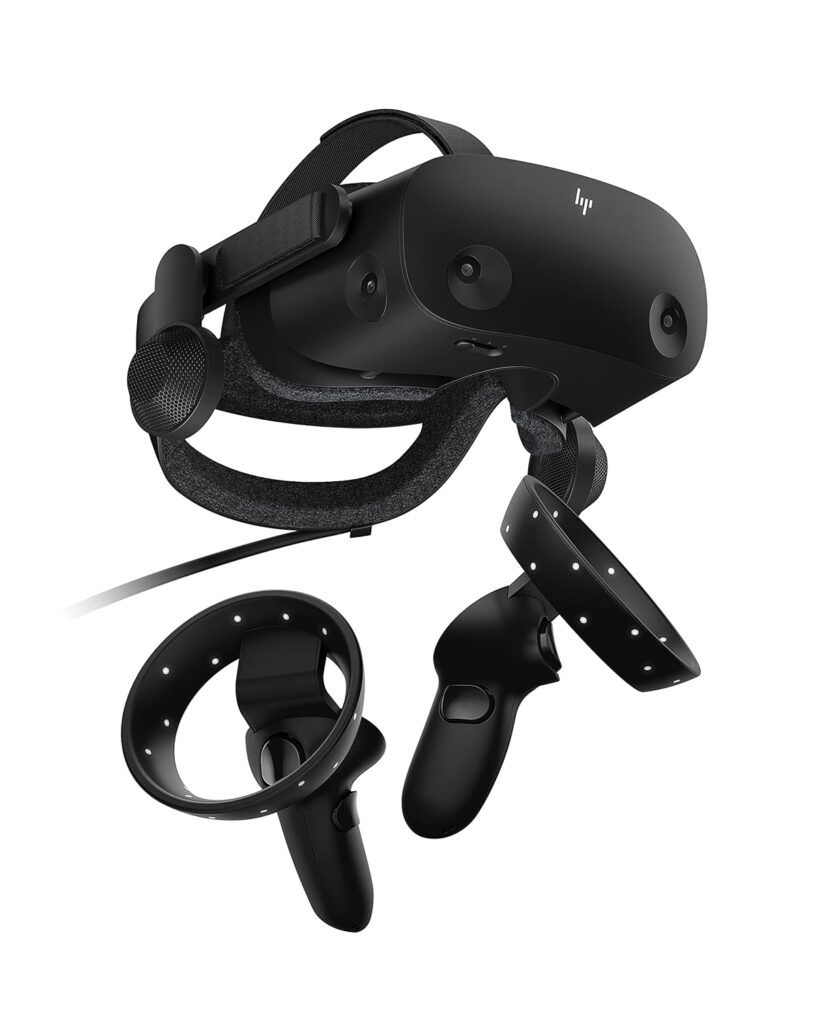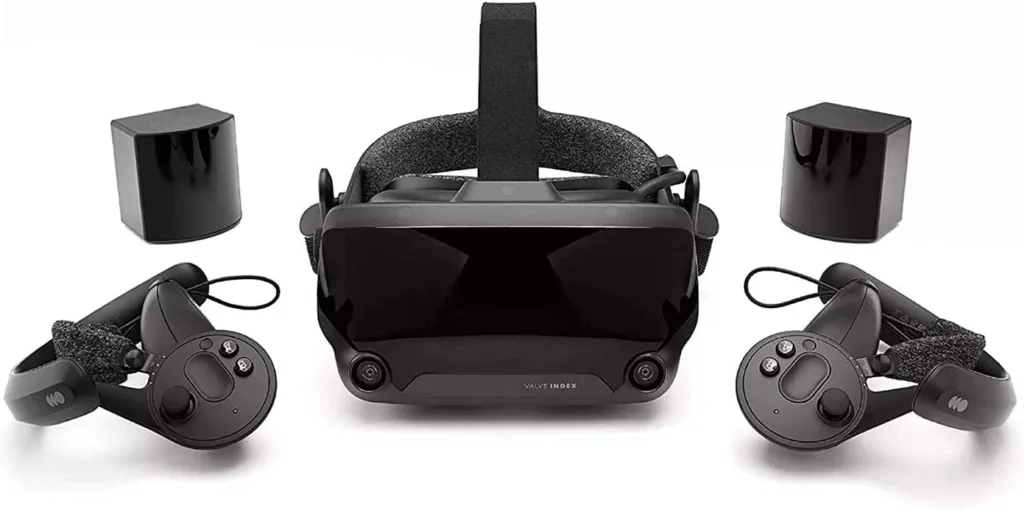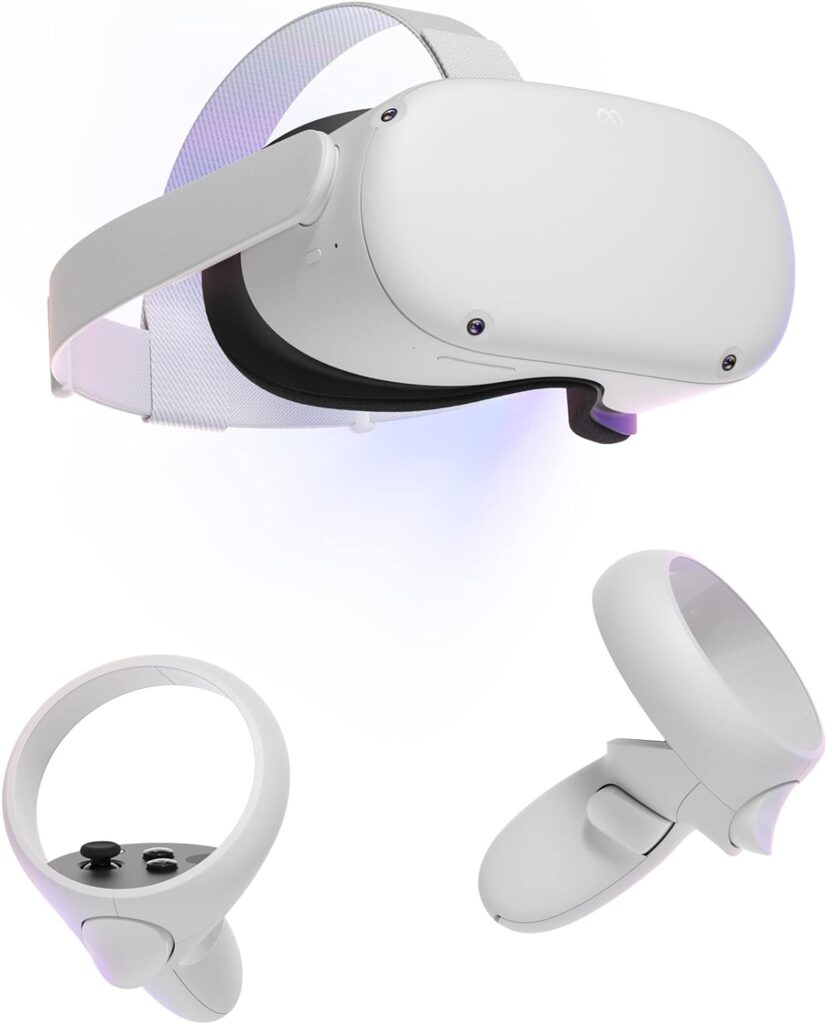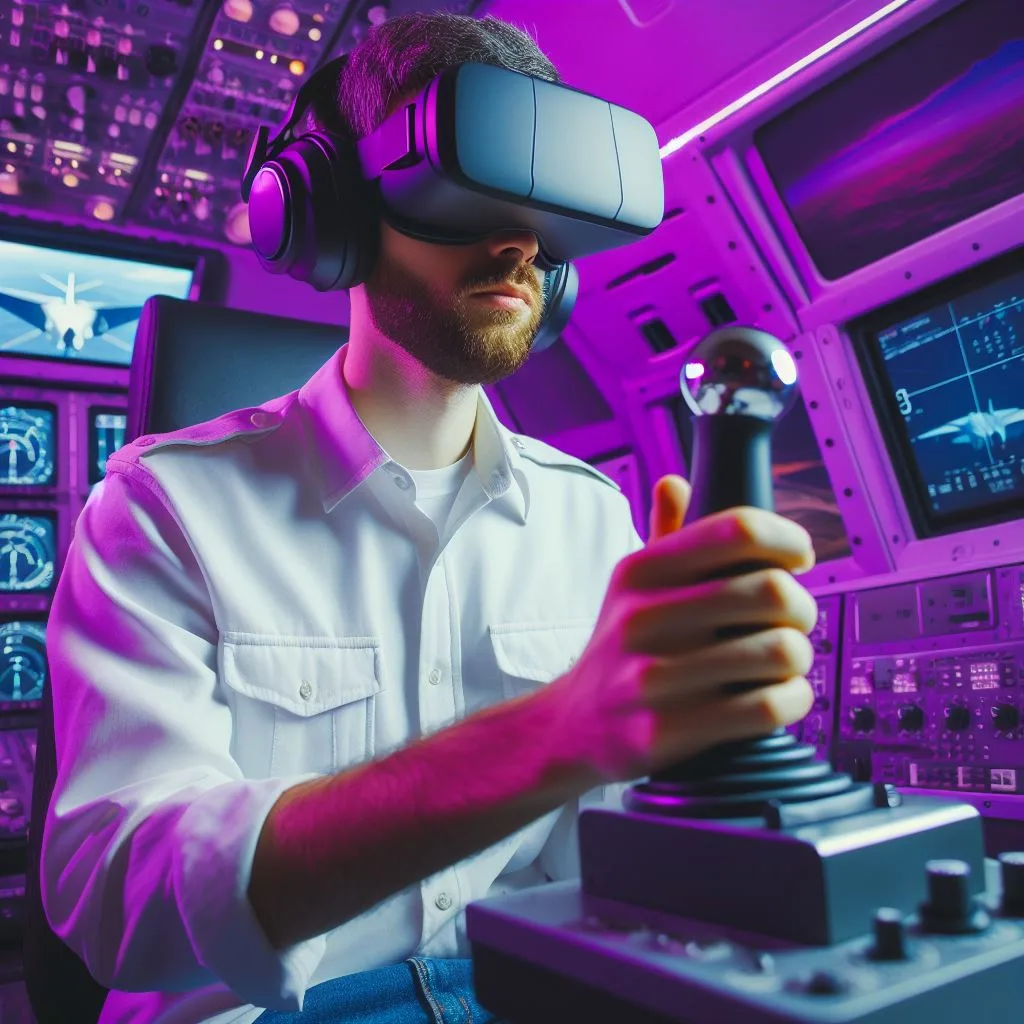Virtual reality (VR) is a technology that allows you to immerse yourself in a simulated environment and experience it as if you were there. VR flight simulation is a popular application of VR that lets you fly a plane or a helicopter in realistic scenarios, from soaring over scenic landscapes to engaging in thrilling dogfights.
VR flight simulation can be a fun and rewarding hobby, but it also requires a good VR headset to enjoy it fully. A VR headset is a device that you wear on your head that displays images and sounds that match your head movements and due to the the 3D effect created by the display and lenses, creates a sense of presence in the virtual world. In this article will be discussing the top 5 best VR headsets for Flight simulators.
Also check out our picks for the Best VR headsets for Sim Racing
Key Takeaways
| VR Headset | Resolution | FOV | Refresh Rate | Price | Pros | Cons |
|---|---|---|---|---|---|---|
| HP Reverb G2 | 2160×2160 per eye | 114° | 90Hz | $599 | High-resolution displays, good value for money | Narrow FOV, mediocre tracking |
| Pimax Crystal | 2880×2880 per eye | Up to 140° | 72 to 160 Hz | $1599 | Highest resolution, super-wide FOV, eye tracking, foveated rendering | Most expensive, bulky, requires powerful PC |
| Valve Index | 1440×1600 per ye | 130° | 80 to 144 Hz | $1000 | High refresh rate, accurate finger tracking controllers | Requires external base stations |
| Meta Quest 2 | 1832×1920 per eye | 98° | 72 to 120 Hz | $249 | Affordable, wireless, good library of VR games | Lower resolution, requires Oculus Link cable for PC |
| Varjo Aero | 2880×2720 per eye | 115° | 90 Hz | $990 | High-resolution displays, eye tracking, aspherical lenses, foveated rendering | Expensive, requires external base stations |
There are many VR headsets on the market, but not all of them are best suited for flight simming. Some of the key factors to consider when choosing a VR headset for flight sims are:
- Resolution: The number of pixels that the headset displays per eye. A higher resolution means sharper and clearer images, which can enhance the realism and immersion of the flight sim. However, a higher resolution also requires more processing power and may affect the performance of the VR system.
- Field of view (FOV): The angle of vision that the headset covers. A wider FOV means a more expansive and immersive view of the virtual environment, which can improve the sense of presence and spatial awareness in the flight sim. However, a wider FOV also requires more processing power and may cause distortion or warping of the images at the edges of the screen.
- Comfort: The weight, size, shape, and fit of the headset. A comfortable headset means a more enjoyable and longer VR session, which is important for flight simming. Comfort depends on factors such as the padding, straps, ventilation, and adjustability of the headset, as well as the user’s personal preference and head shape.
- Tracking accuracy: The ability of the headset to track the user’s head movements and translate them into the virtual world. A more accurate tracking means a more responsive and smooth VR experience, which can reduce motion sickness and increase immersion in the flight sim. Tracking accuracy depends on factors such as the sensors, cameras, and base stations that the headset uses, as well as the calibration and setup of the VR system.
Best VR Headsets for Flight Simulators
Based on the factors mentioned above, here are the top 5 VR headsets for flight simulators in 2024, along with their specs, pros, and cons.
Amazon Affiliate Disclaimer:
This website is a participant in the Amazon Services LLC Associates Program, an affiliate advertising program designed to provide a means for sites to earn advertising fees by advertising and linking to Amazon.com. As an Amazon Associate, we earn from qualifying purchases. We get commissions for purchases made through links in this website. Amazon and the Amazon logo are trademarks of Amazon.com, Inc., or its affiliates.
Varjo Aero
Our pick for the Best VR headset for flight simulators is The Varjo Aero, which is a VR headset that offers high-resolution displays, eye tracking, aspherical lenses, and foveated rendering for better performance. It is a professional-grade headset that is designed for high-end VR applications, such as training, simulation, and design.
The Varjo Aero features dual LCD displays, with eye tracking and custom-made variable resolution aspheric lenses (increased clarity with no glare or god rays) at a resolution of 2880 x 2720 per eye and a natural and distortion-free horizontal FOV of 115°, and a refresh rate of 90 hz. It also uses SteamVR base stations for tracking and comes in at $990
The Varjo Aero is a VR headset that can offer a stunning and realistic VR experience for flight simmers who want to see the virtual world almost as clearly as the real one. It also has a comfortable and lightweight design, a high-quality audio system, and a user-friendly software. However, it is also an expensive and demanding headset that requires a high-end PC and external base stations to run. It may also have compatibility and availability issues.
Pimax Crystal

The Pimax Crystal is a VR headset that boasts the highest resolution and the widest FOV among the current VR headsets. It is a premium headset that aims to deliver the ultimate VR experience for enthusiasts and professionals. The Pimax Crystal can be used in standalone mode, connected to the PC with inside-out tracking, or can be used with SteamVR base stations and controllers with the purchase of the optional faceplate.
The Pimax Crystal features a dual QLED mini led panels with a resolution of 2880×2720 per eye, a refresh rate of 72 to 160 Hz and a horizontal field of view of 140, with eye tracking for IPD detection and adjustment, and foveated rendering. The lenses are of a glass aspherical design which are MUCH clearer and do not feature the glare and “god ray” effects the fresnel lenses do which are found in most consumer VR headsets. All those premium features come at a premium cost of $1600 for just the headset, which is the most expensive on this list.
The Pimax Crystal is a VR headset that can offer an unparalleled level of immersion and realism for flight simmers who want to see every detail and feel like they are in the cockpit. However, it is also the most expensive, bulky, and demanding headset on the market. It requires a powerful PC, and a lot of tweaking and troubleshooting to run smoothly. It may also cause eye strain, headaches, and nausea for some users due to the distortion and warping of the images.
HP Reverb G2

The HP Reverb G2 is a VR headset that offers high-resolution displays, and good value for money, It is a successor to the HP Reverb, which was praised for its sharp visuals but criticized for its audio and tracking. The HP Reverb G2 improves on these aspects by featuring Valve-designed speakers, which is considered to be the best on the market, and four cameras for inside-out tracking. It also has an adjustable IPD dial.
The HP Reverb G2 featured a dual LCD display with a resolution of 2160×2160 per eye, a horizontal Field of View of 114° and a Refresh Rate of 90Hz. The HP reverb comes in at a reasonable price of $599
The HP Reverb G2 is a good choice for flight simmers who want to enjoy crisp and clear images without breaking the bank. However, it also has some drawbacks, such as a narrow FOV, and the inside out tracking not being as good as the tracking seen on headsets like the rift s or quest 2. Some users also had complaints about the windows mixed reality platform.
Valve Index

The Valve Index is a VR headset that offers a high refresh rate, accurate finger tracking controllers, and a balanced performance. It is a flagship headset that is designed by Valve, the company behind Steam and Half-Life. It features dual LCD displays, a mechanical IPD adjustment, and a comfortable and adjustable fit. It also uses external base stations for precise and reliable tracking.
The Valve Index features a Dual 1440 x 1600 LCD display with a horizontal field of view at 130 a refresh rate of 80 up to 144 frames per second.
The Valve Index is a VR headset that can provide a smooth and responsive VR experience for flight simmers who want to feel the speed and motion of the flight. It also has a wide FOV, a what is considered by many to have the best audio system. However, due to the nature of the SteamVR lighthouse tracking system, setup can be a somewhat complex and time consuming process. It may also suffer from glare, and god rays, due to the nature of the double stack lens design.
Meta Quest 2

The Meta Quest 2 is a VR headset that offers an affordable, wireless, and versatile option for VR gaming. It is a standalone headset that does not require a PC or a phone to run. It has a built-in processor, battery, storage, and speakers. It also has four cameras for inside-out tracking and touch controllers. It can run a variety of VR games and apps from the Meta Store, as well as stream PC VR games through the Oculus Link cable.
The quest 2 has a single LCD display with a resolution: 1832 x 1920 per eye, a refresh rate of 72 to 120 Hz and a FOV of 98 degrees, all with a price tag of $249
The Meta Quest 2 is a VR headset that can offer a convenient and accessible VR experience for flight simmers who want to enjoy VR without the hassle of wires and PC requirements. It also has a good battery life, a sleek design, and a large user base. However, it also has a lower resolution, a smaller FOV, and a limited processing power compared to other PC VR headsets. It also requires a Facebook account to use and may have privacy and data issues.
How to Choose the right Headset
As you can see, there are many VR headsets to choose from, each with its own strengths and weaknesses. The best headset for you depends on your personal preferences, needs, and budget. Here are some questions to ask yourself when choosing a VR headset for flight simming:
Cost
VR headsets vary widely in price, from $249 for the Meta Quest 2 to $1599 for the Pimax Crystal. Generally, the more expensive the headset, the better the performance and features, but also the higher the PC requirements and the more complex the setup. If you are on a tight budget, you may want to opt for a more affordable and simple headset, such as the Meta Quest 2 or the HP Reverb G2. If you have more money to spare, you may want to invest in a more premium and immersive headset, such as the Varjo Aero or the Pimax Crystal.
Resolution and FOV
Resolution and FOV are two of the most important factors for VR immersion and realism, especially for flight simming. A higher resolution and a wider FOV can make you feel like you are really in the cockpit, seeing every detail and having a panoramic view of the sky. However, a higher resolution come with trade-offs, such as lower performance and higher PC requirements, and a wider FOV can also come with some trade-offs, such as more distortion in some cases.
If you value resolution above all else, you may want to go for the Pimax Crystal and Varjo Aero. If FOV is what you want, you can’t go wrong with the Pimax Crystal or Valve Index which offer the widest FOV among the VR headsets. If you are more concerned about performance and compatibility, you may want to choose a headset with a lower resolution and a narrower FOV, such as the Meta Quest 2 or the HP Reverb G2.
Comfort
Comfort is another important factor for VR enjoyment and longevity, especially for flight simming. A comfortable headset can make you forget that you are wearing a device on your head and focus on the flight. Comfort depends on factors such as the weight, size, shape, and fit of the headset, as well as the user’s personal preference and head shape. Some headsets are more comfortable than others, such as the Varjo Aero or the Valve Index, which have a lightweight and adjustable design, a good padding, and a balanced weight distribution.
Tracking Reliability and Accuracy
Tracking is another important factor for VR responsiveness and smoothness, especially for flight simming. A reliable and accurate tracking can make you feel like you are really controlling the plane, matching your head movements and inputs with the virtual world. Tracking depends on factors such as the sensors, cameras, and base stations that the headset uses, as well as the calibration and setup of the VR system.
Some headsets have more reliable and accurate tracking than others, such as the Valve Index or the Varjo Aero, which use external base stations for tracking and have a high refresh rate and a low latency. Some headsets have less reliable and accurate tracking than others, such as the HP Reverb G2 or the Meta Quest 2, which use inside-out tracking and have a lower refresh rate and a higher latency.
To help you decide which headset is the best for you, here is a decision-making table that summarizes the pros and cons of each headset based on the factors discussed above:
| VR Headset | Price | Resolution | FOV | Tracking | Best for |
|---|---|---|---|---|---|
| HP Reverb G2 | $599 | High | Standard | OK | Budget-conscious users who want high-resolution displays |
| Pimax Crystal | $1599 | Highest | Widest | Good | Enthusiasts and professionals who want the ultimate VR immersion and realism |
| Valve Index | $1000 | High | Wide | Excellent | Gamers and simmers who want a smooth and responsive VR experience and accurate finger tracking controllers |
| Meta Quest 2 | $249 | Low | Standard | Good | Casual users who want a convenient and accessible VR experience without wires and PC requirements |
| Varjo Aero | $990 | Very High | Wide | Excellent | Simmers and designers who want a stunning and realistic VR experience with eye tracking and foveated rendering |
Additional Tips for VR Flight Simming
Once you have chosen the right VR headset for you, you may want to enhance your VR flight simming experience with some additional software and accessories. Here are some recommendations and tips for VR flight simming:
- VR flight simulation software: There are many VR flight simulation software available, but some of the most popular and realistic ones are Microsoft Flight Simulator 2020, X-Plane 11, and DCS World. These software offer a variety of planes, helicopters, scenarios, and settings to choose from, as well as realistic physics, graphics, and sounds. They also support most VR headsets and controllers, as well as custom mods and add-ons. You can find these software on Steam or their official websites.
- VR flight simulation accessories: To make your VR flight simming more immersive and realistic, you may want to use some accessories, such as joysticks, rudders, and hotas setups. These accessories can give you more control and feedback over the flight, as well as a more authentic feel of the cockpit. You can find these accessories on Amazon or other online stores, or you can build your own DIY setup with some creativity and skills.
- Optimizing VR performance and settings: To ensure a smooth and enjoyable VR flight simming experience, you may want to optimize your VR performance and settings. This involves adjusting the graphics, sound, and gameplay options of the VR software and the VR headset to match your PC specifications and preferences. You may also want to use some tools, such as FPSVR or OpenVR Advanced Settings, to monitor and tweak your VR performance and settings in real time. You can find these tools on Steam or their official websites.
Conclusion
VR flight simulation is a fascinating and exciting hobby that can let you experience the thrill and beauty of flying in a virtual world. However, it also requires a good VR headset and other accessories like a joystick and throttle, also known as HOTAS, to enjoy it fully. A good VR headset for flight simming should have a high resolution, a wide FOV, a comfortable fit, and a reliable tracking, among other factors. There are many VR headsets to choose from, each with its own pros and cons, and the best headset for you depends on your personal preferences, needs, and budget.
We hope this article has helped you learn more about the best VR headsets for flight simulators in 2023 and how to choose the right one for you. We encourage you to explore the world of VR flight simming and choose the headset that best suits your needs and budget. Happy flying!
Subscribe now for hand-picked best experiences, product discounts, and the latest VR trends, tips and tricks, straight to your inbox.



Leave a Reply